The format of presentations versus catwalk shows has changed the consumption of collections at London Fashion week. Presentations give designers on smaller budgets with big ideas the platform to express all the ambition and concept, without the frantic pace and crippling cost of a seven (or so) minute show.
A show is fleeting. A presentation distills and simmers, offering an entire crafted and installed concept, not just clothing, As seen at the brilliant Wolves PR presentation spaces in the Elms Lesters Painting Rooms, the designers and their teams built a world around the clothes using the set, sound and architecture of the space. Compared to a show, a presentation offers more to grab onto in terms of the story behind the collection and the clothing itself.
During the presentations at Elms Lesters Painting Rooms there was time to be consumed by the building and the designer's visual storytelling. Not having show notes to read through while sitting, waiting for a show to start means no advance intro to the clothing and seasonal theme, however a presentation offers less pretence and puts the experience above all else.
![2016-02-21-1456049491-4491927-DSC00295.jpg]()
![2016-02-21-1456049521-5800359-DSC00296.jpg]()
![2016-02-21-1456049569-147729-DSC00298.jpg]()
![2016-02-21-1456049677-2384358-DSC00314.jpg]()
Georgia Hardinge - AW16 'Hidden" collection
Viewers are invited to interact with the space, the models and the clothes. Want detail pics? No problem. Want to engage with the models for a beauty shot? Sure. Paradoxically, by allowing viewers to take a greater part in the presentation the designers are able to present their story more strongly. A show can be distracting and the format detracting. There's so much looking around, flash bulb mania, show guest antics and FROW chat that the show itself doesn't always feel like the main event. I guess any kind of presentation or show is really about engagement, and that seems more effective and sustained in a presentation format.
![2016-02-21-1456099077-8767899-DSC00381.jpg]()
![2016-02-21-1456099105-6557313-DSC00384.jpg]()
![2016-02-21-1456099131-6414124-DSC00385.jpg]()
![2016-02-21-1456099158-6736592-DSC00388.jpg]()
Omer Asim - AW16 Collection
I wandered backstage at Gabriel Vielma's presentation where Gabriel guided me to the area with the best light to photograph the models as they exited to join the presentation. His hair and make up team were just as sweet and friendly as he was. See, that's the side of fashion hidden behind the facade of a show. The designers, the production teams, the hair and makeup team, the assistants - so many sweet, creative people working their butts off. The story on the other side in the front row is so very different. Distance between the fashion machine and the consumer (buyers/press/stylists attending fashion shows) makes sense, sure, but my curiosity (possibly nosiness) means I find the story behind the story so much more interesting, and presentations bring the viewers closer to the inner workings of the collection and the designer and their team. Designers presenting rather than showing get the chance to interact openly with their models and the set throughout the presentation - you see them working. They can also openly chat with press/bloggers/plucky civilians and in a relationship and social-media-led industry it feels like a great way to go about building a loyal brand following and grab column inches. Did I mention how photographable presentations are? There's time to compose shots that represent the clothing and set and (hopefully) do them justice.
![2016-02-22-1456099285-3849794-DSC00270.jpg]()
![2016-02-22-1456099316-31856-DSC00282.jpg]()
Behind the scenes - Gabriel Vielma AW16
Gabriel Vielma's website lured me in with cut and paste animated graphics and x-ray imagery. The invitation was illustrated with instructions on how to wear a life jacket. The promise of tech and lives saved materialised in the form of a constructed pipe rig with tablets affixed showing doe eyed graphics with a distinct manga quality. The presentation literature cited the inspiration as Wes Anderson's The Life Aquatic With Steve Zissou and nautical notes expressed via sailors braids and flocks of seabirds on jacquard knitwear, a first for the designer. The entire collection was made in the UK, including the knitwear which was made in Leicester. The evolution of knitwear in emerging designers brought about by accessibility to machinery via Stoll and Shima in the UK is heartening and inspiring. What used to be such a tough category created at arms-length in far flung factories is now bubbling up with creativity and cohesiveness alongside the woven and print elements of collections.
![2016-02-22-1456099585-2028290-ScreenShot20160220at22.24.28.png]()
![2016-02-22-1456099614-4185630-ScreenShot20160220at22.25.57.png]()
vielma.co.uk
![2016-02-22-1456099676-6595260-ScreenShot20160220at22.23.08.png]()
![2016-02-22-1456099700-3480818-DSC00249.jpg]()
![2016-02-22-1456099731-9246318-DSC00251.jpg]()
![2016-02-22-1456099760-9121351-DSC00262.jpg]()
![2016-02-22-1456099791-947582-DSC00257.jpg]()
Gabriel Vielma - 'Beside the Seaside' AW16 Collection
Another collection integrating knitwear with woven textiles plus a moss-driven biological and futuristic sci-fi leaning was by Minki Cheng. The set looked like an about-to-be-electrified urban moss-scape - a kind of techno / bio patch for his hybrid texture clothing. I'll be zooming in on the details again tomorrow at the Designer Showrooms and getting to the bottom of the incredible soundscape documented visually (sort of) below, with Minki snapped alongside the composer in one shot.
![2016-02-22-1456099993-4918595-DSC00348.jpg]()
![2016-02-22-1456100030-8203338-DSC00350.jpg]()
![2016-02-22-1456100068-7893764-DSC00352.jpg]()
![2016-02-22-1456100308-593427-DSC00375.jpg]()
![2016-02-22-1456100111-8529804-DSC00355.jpg]()
![2016-02-22-1456100163-480147-DSC00361.jpg]()
![2016-02-22-1456100215-4621211-DSC00366.jpg]()
![2016-02-22-1456100252-9243193-DSC00374.jpg]()
Minki Cheng - AW16
Chatting to Justine Fairgrieve, founder of The Wolves PR (who I met years ago during her Relative PR days), she was buzzing with excitement alongside her Wolverines. Inspired by visiting a space created by a PR company offering a potent metaphor for the hunger and ambition of emerging fashion designers means I'll be stopping by to chat to the Wolves again soon. Justine's pack held engaging presentations with punch and polish. More where they came from!
Follow me on Instagram @techstyler
A show is fleeting. A presentation distills and simmers, offering an entire crafted and installed concept, not just clothing, As seen at the brilliant Wolves PR presentation spaces in the Elms Lesters Painting Rooms, the designers and their teams built a world around the clothes using the set, sound and architecture of the space. Compared to a show, a presentation offers more to grab onto in terms of the story behind the collection and the clothing itself.
During the presentations at Elms Lesters Painting Rooms there was time to be consumed by the building and the designer's visual storytelling. Not having show notes to read through while sitting, waiting for a show to start means no advance intro to the clothing and seasonal theme, however a presentation offers less pretence and puts the experience above all else.
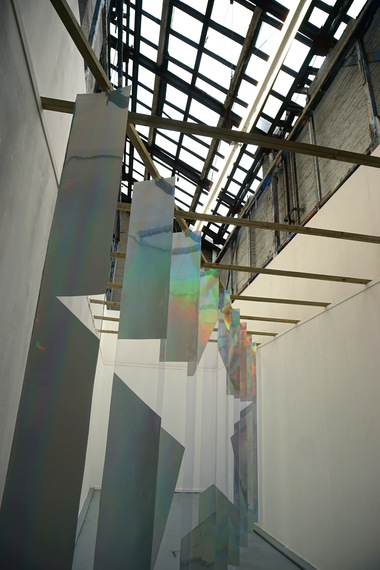

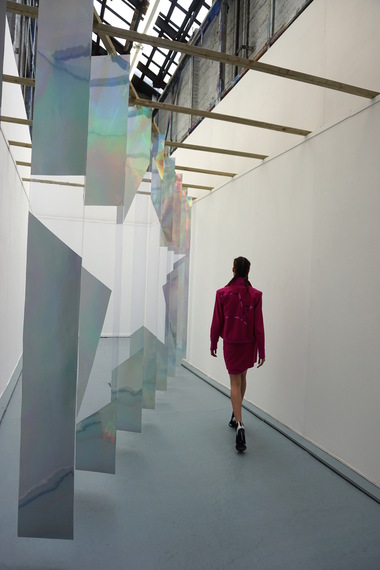

Georgia Hardinge - AW16 'Hidden" collection
Viewers are invited to interact with the space, the models and the clothes. Want detail pics? No problem. Want to engage with the models for a beauty shot? Sure. Paradoxically, by allowing viewers to take a greater part in the presentation the designers are able to present their story more strongly. A show can be distracting and the format detracting. There's so much looking around, flash bulb mania, show guest antics and FROW chat that the show itself doesn't always feel like the main event. I guess any kind of presentation or show is really about engagement, and that seems more effective and sustained in a presentation format.
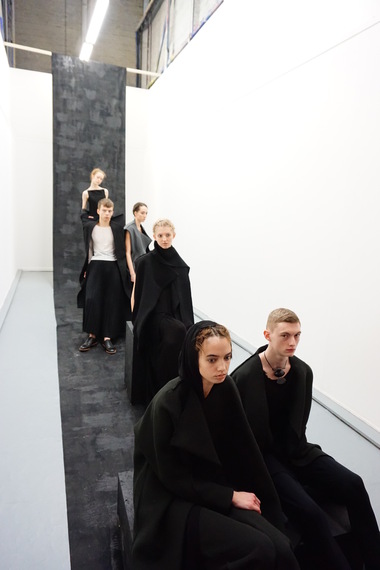

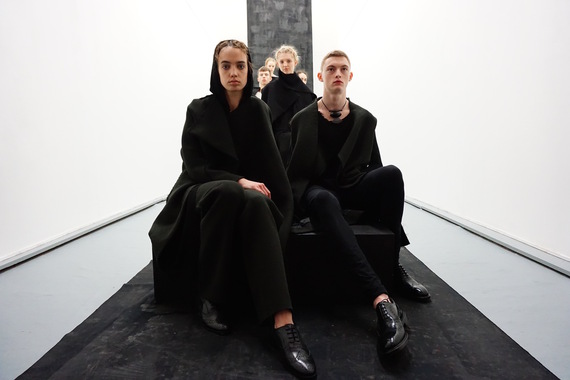
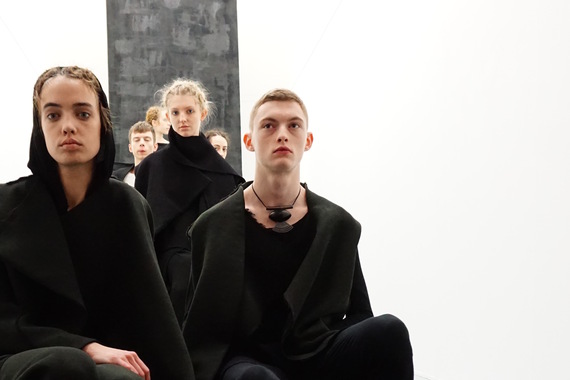
Omer Asim - AW16 Collection
I wandered backstage at Gabriel Vielma's presentation where Gabriel guided me to the area with the best light to photograph the models as they exited to join the presentation. His hair and make up team were just as sweet and friendly as he was. See, that's the side of fashion hidden behind the facade of a show. The designers, the production teams, the hair and makeup team, the assistants - so many sweet, creative people working their butts off. The story on the other side in the front row is so very different. Distance between the fashion machine and the consumer (buyers/press/stylists attending fashion shows) makes sense, sure, but my curiosity (possibly nosiness) means I find the story behind the story so much more interesting, and presentations bring the viewers closer to the inner workings of the collection and the designer and their team. Designers presenting rather than showing get the chance to interact openly with their models and the set throughout the presentation - you see them working. They can also openly chat with press/bloggers/plucky civilians and in a relationship and social-media-led industry it feels like a great way to go about building a loyal brand following and grab column inches. Did I mention how photographable presentations are? There's time to compose shots that represent the clothing and set and (hopefully) do them justice.
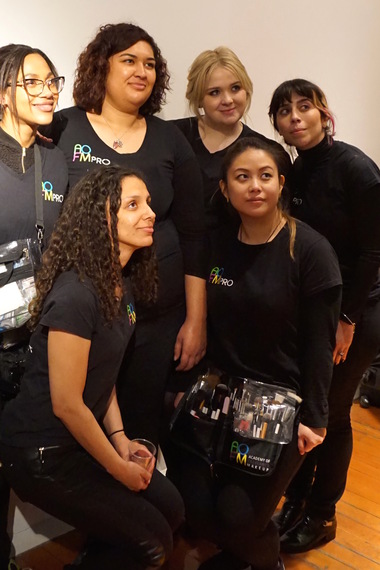
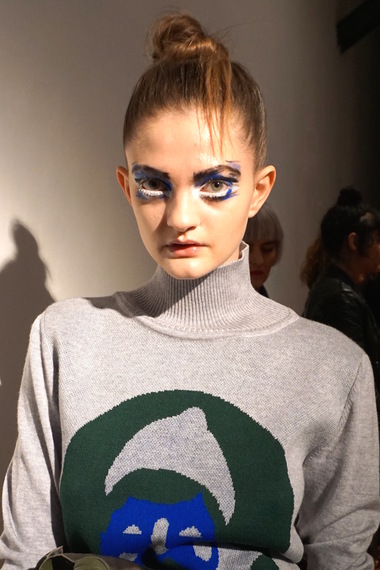
Gabriel Vielma's website lured me in with cut and paste animated graphics and x-ray imagery. The invitation was illustrated with instructions on how to wear a life jacket. The promise of tech and lives saved materialised in the form of a constructed pipe rig with tablets affixed showing doe eyed graphics with a distinct manga quality. The presentation literature cited the inspiration as Wes Anderson's The Life Aquatic With Steve Zissou and nautical notes expressed via sailors braids and flocks of seabirds on jacquard knitwear, a first for the designer. The entire collection was made in the UK, including the knitwear which was made in Leicester. The evolution of knitwear in emerging designers brought about by accessibility to machinery via Stoll and Shima in the UK is heartening and inspiring. What used to be such a tough category created at arms-length in far flung factories is now bubbling up with creativity and cohesiveness alongside the woven and print elements of collections.
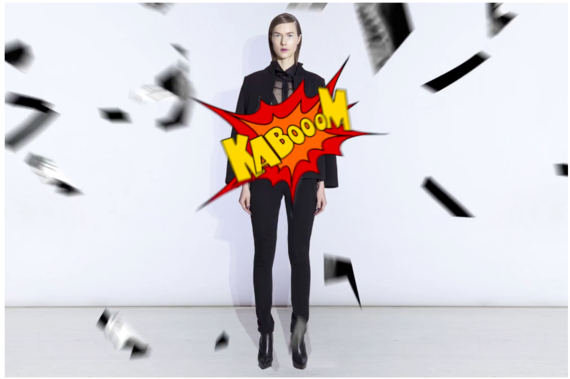
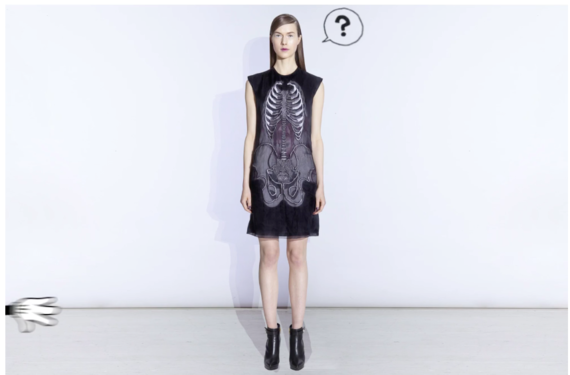
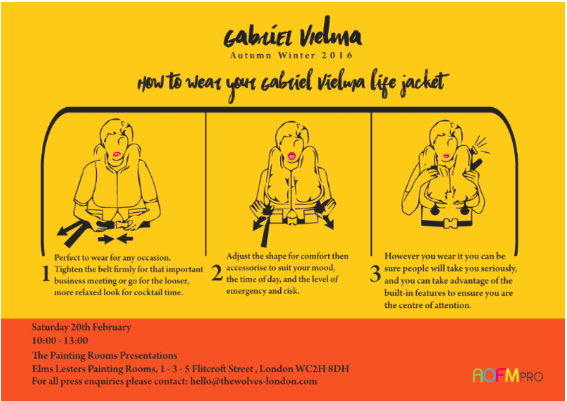
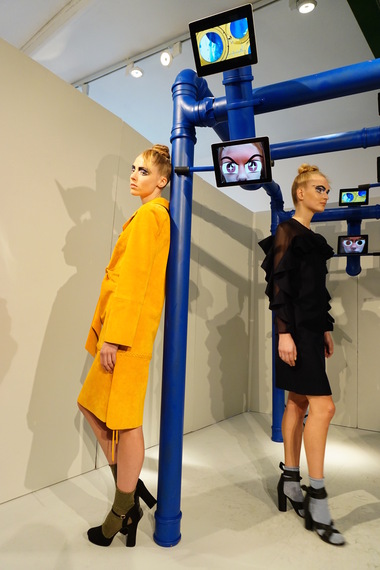
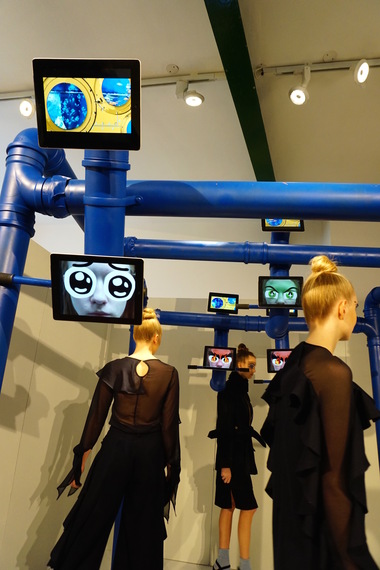
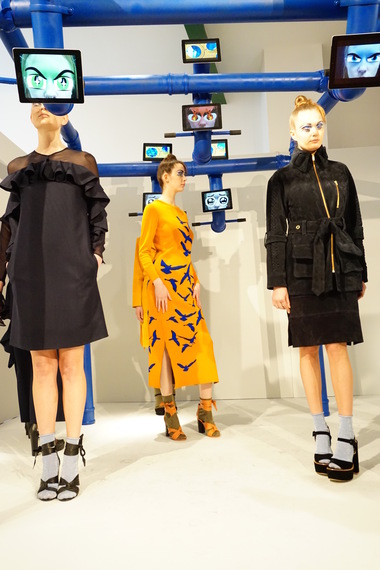
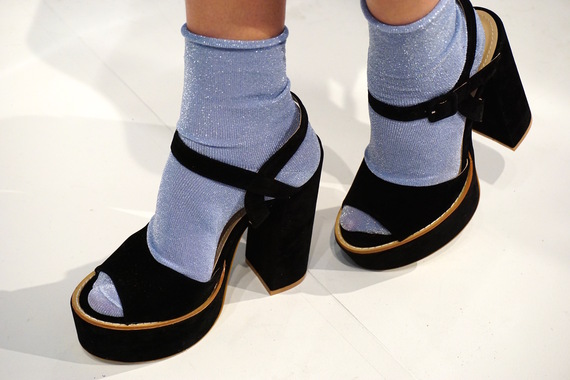
Another collection integrating knitwear with woven textiles plus a moss-driven biological and futuristic sci-fi leaning was by Minki Cheng. The set looked like an about-to-be-electrified urban moss-scape - a kind of techno / bio patch for his hybrid texture clothing. I'll be zooming in on the details again tomorrow at the Designer Showrooms and getting to the bottom of the incredible soundscape documented visually (sort of) below, with Minki snapped alongside the composer in one shot.
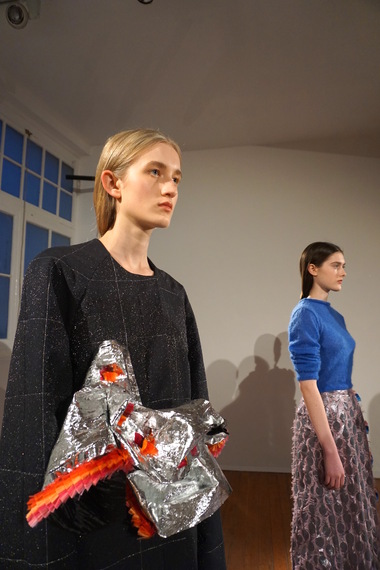
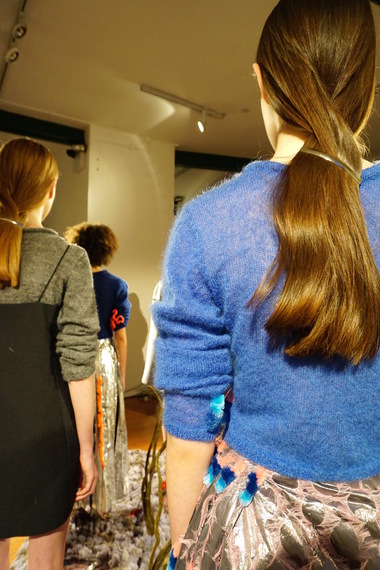
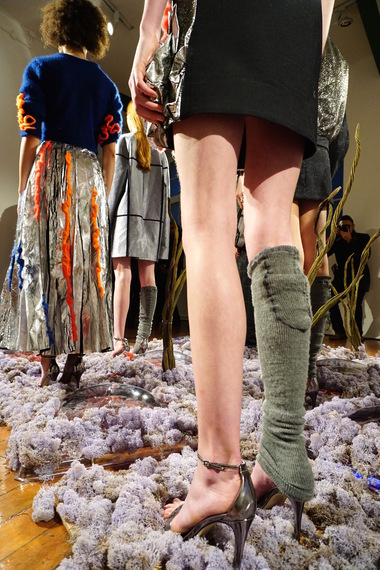
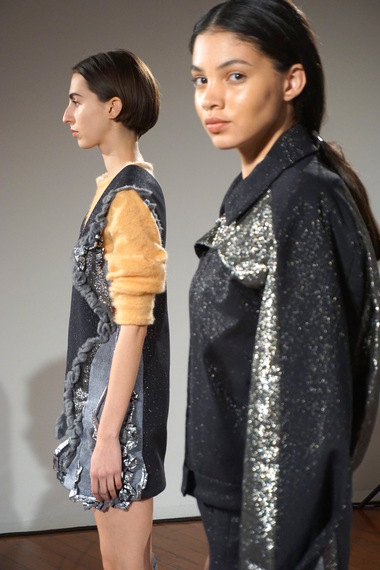
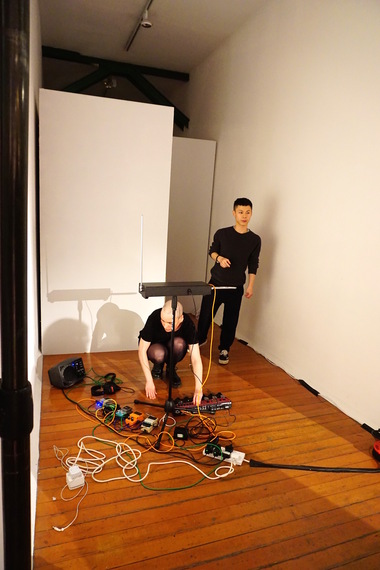



Chatting to Justine Fairgrieve, founder of The Wolves PR (who I met years ago during her Relative PR days), she was buzzing with excitement alongside her Wolverines. Inspired by visiting a space created by a PR company offering a potent metaphor for the hunger and ambition of emerging fashion designers means I'll be stopping by to chat to the Wolves again soon. Justine's pack held engaging presentations with punch and polish. More where they came from!
Follow me on Instagram @techstyler